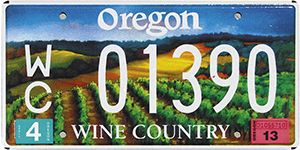License to Wine
Wine Country Plate Grant Program to allocate funds

In 2011, the Oregon Tourism Commission, better known under its Travel Oregon marketing moniker, proposed what turned out to be a good idea, at least in principle: Let’s have the DMV offer another of those cool license plates like the ones honoring Crater Lake, Oregon salmon and the Cultural Trust.
And what leaps immediately to mind these days regarding Oregon tourism, besides the rugged mountain, forest and seacoast landscape? The wine industry, of course.
Wine country would be a new and different addition to the existing license plates. The proceeds would, fittingly, go toward promoting tourism in Oregon wine regions.
Well, the plate looks great, raising almost $480,000 to date, half designated for distribution through matching grants; the other half for direct promotion of wine region amenities. However, as with almost anything involving “free” government money, qualifying becomes a bit complicated.
Logic would dictate the discretionary portion be allocated according to where it would do the most good. In the case of the wine industry, that would be where the majority of grapes are grown and most wine produced.
Nearly 50 percent of the state’s wineries are located in Yamhill County, where almost 70 percent of its signature Pinot Noir is produced. So it figures a considerable portion of the license plate funds should be spent here — maybe even half.
The program’s authorizing language also commits it to promoting the culinary industry, closely allied with wine. And Wine Country dining and lodging tend to be concentrated in the rolling hills where the grapes or nearby towns where the wineries and tasting rooms are located.
But one person’s logic can be another person’s inequity.
According to Linea Gagliano, Travel Oregon’s industry and public affairs manager, current thinking is that the money should be spread as widely as possible. Allocating half the take to one region wouldn’t leave enough among the rest, to the agency’s line of reasoning.
The Oregon Tourism Commission recognizes four major wine-producing regions. Region 1 consists of Marion, Polk and Yamhill counties; Region 2: Lane, Linn, Benton, Lincoln, Tillamook, Clatsop, Columbia, Washington, Multnomah and Clackamas; Region 3: Coos, Curry, Douglas, Josephine, Jackson, Klamath and Lake; and Region 4: Hood River, Wasco, Sherman, Gilliam, Morrow, Umatilla, Wallowa, Jefferson, Deschutes, Crook, Wheeler, Grant, Harney, Baker and Malheur counties.
To participate in the wine country license plate program, each of these regions must be represented by a tourism promotion agency selected by the OTC. They must qualify as destination marketing organizations, or DMOs, which means they must document past experience with travel and tourism clients.
This stipulation may be the major sticking point, as it would be incumbent on DMO hopefuls to develop promotional strategies encompassing the entire region they aim to serve. Yet only a relatively handful of Oregon counties can truly call themselves major players.
Complicating the matter even further, Travel Oregon is emphasizing “creative” ways of augmenting tourism. It is planning to reserve half of its fund to outside-the-box proposals.
With all those wrinkles, perhaps it’s not surprising that guidelines have still not been finalized, so not a single penny has yet been distributed, some four years after the plates first went on sale. The powers that be in Oregon tourism say they are getting close. But this is public money, intended to be spent for the public good, so, of course, public input is necessary. Testimony must be taken.
Travel Oregon scheduled a public hearing for Thursday, Feb. 19, at the Seaside Civic and Convention Center. It also agreed to accept written testimony, too. April 12–14, attendees to the 2015 Oregon Governor’s Conference on Tourism had the opportunity to attend a grant writing workshop in Eugene, where details about the Wine Country License Plate Grant Program were given.
OTC says the latest specifics and timetable will be announced by May 1 (after this publication has gone to print). Please refer to www.industry.traveloregon.com/industry-resources/matching-grants-program for the latest information.










